Brentc
Well-known member
- Joined
- Mar 14, 2019
- Messages
- 215
I do!
My good friend Jeremy and I beat the 1% odds and the drew the Nunivak Island Muskox tag in the 2019 draw. The first thing we did is call James Whitman for transporter services. In Alaska, a transporter is a happy medium between a DIY and fully guided. The transporter provides food, lodging and transportation while you’re there and they make sure you get to the field and back safely. They cannot help you judge trophy quality or help you break down your animal after you kill it, but having snow machines, hot meals, and a warm place to stay is worth the cost.
We flew from Fairbanks on February 14th and arrived in Bethel the same night. That’s the point where things came to a screeching halt. We were supposed to start our hunt on the 15th, however, the entire Western coast of AK was under blizzard advisory and low visibility. We ended up spending four nights in Bethel waiting for the weather to clear enough to fly to Nunivak. Although our timeline shifted a few days, and client reservations were bumping in to each other, James remained willing to work with us to get us our animals.
We finally got to Nunivak on February 19th. James was at the flight strip with his assistants waiting to get us going. We had a few hours of daylight remaining so we loaded up the sleds and got out for a ride. We saw dozens of red foxes, several herds of reindeer, and a few muskoxen. No mature bulls, though.
Thursday and Friday were no travel days due to high winds and fog, so we stayed in James’s house. I pulled out some "wizardry" when I shared my phone screen to the Smart TV in James's house. We all watched several previously downloaded episodes of Fresh Tracks and Meateater. We ended up watching the Meateater Nunivak episode several times, since James was Steve Rinella’s guide for his hunt. We were all entertained with James’s behind the scenes stories.
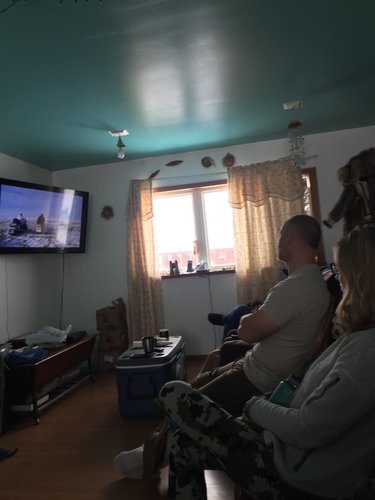
Saturday was the day on the forecast we all looked forward to and it was worth waiting for. The skies were bright and the winds were low. We got an early start because we already knew we had to travel 40 miles to the south side of the island by snow machine to get to the animals.
After seeing several herds of muskoxen with no mature bulls, we found a pair of bulls off by themselves at around 1:00 PM and we made a move to get a good view of them. After getting a good look at both of them, Jeremy and I both decided that these bulls were worth taking. We approached the bulls slowly with Jeremy kicking out and around the bulls as a flanker to force them into a defensive position. I worked into a position 30 yards from the pair of bulls and stuck a Slick Trick through the closest bull. When my bull tipped over, Jeremy and I swapped positions so that he could get a clear shot at the second bull. Jeremy’s shot was true and 2 minutes later we had two mature muskox bulls on the ground side by side. We spent the next 4 ½ hours taking pictures and breaking the bulls down and loading them into the sleds. We ended up back at the village at 10 P.M. due to a few mechanical issues on the way back, but overall, we were happy with the day’s production.
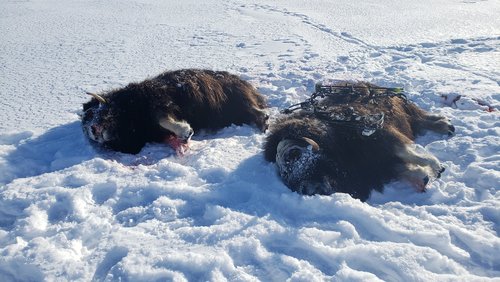
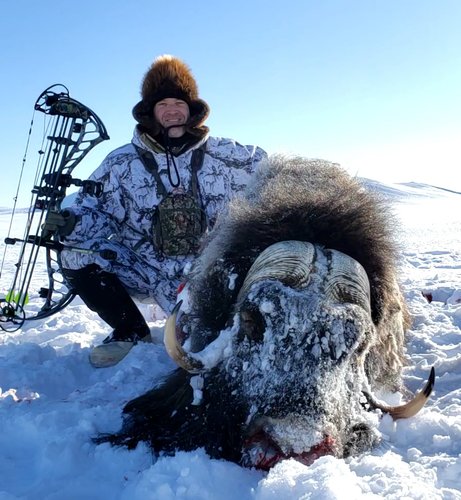
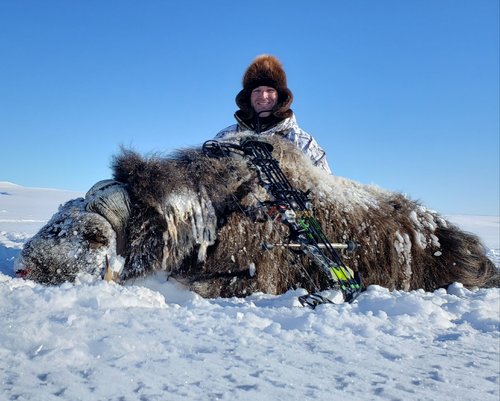
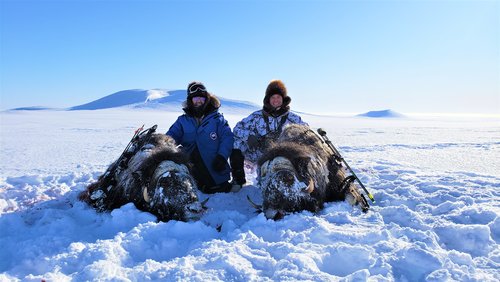
We spent the next day deboning the meat and caping. The deboning was straight forward and relatively easy. However, caping a muskox is anything but easy. If you ever get to do it, make sure you have a long-bladed knife and a screw driver. The space between the horns and face is tight on old bulls! Use the screwdriver to clean the accumulated dirt and hair from the between the horns and the hide, then use the long knife to separate the hide from the skull. Prepare to be frustrated.
Monday was our day to fly out and we were relieved to see another day of good weather. The flight arrived on time with a second plane to fly our gear out. We were worried that we wouldn’t get our gear and meat off of Nunivak until a few days later. We feared that the other transporters in the village were looking to get clients off the island too. The flight out of Nunivak was about the only thing that went smoothly on this hunt as far as flights are concerned. Jeremy and I made it back to Fairbanks with all of our gear, hides, and meat later that evening.
Some advice for the hunt. Follow the packing list that your transporter provides. Get some bunny boots and good cold weather gear rated for 40 below. If you ever get this tag, go into it with an open pocket book and a flexible schedule. We spent six days of our hunt weathered out. It’s not optimal, but we were both determined to make it work.
My good friend Jeremy and I beat the 1% odds and the drew the Nunivak Island Muskox tag in the 2019 draw. The first thing we did is call James Whitman for transporter services. In Alaska, a transporter is a happy medium between a DIY and fully guided. The transporter provides food, lodging and transportation while you’re there and they make sure you get to the field and back safely. They cannot help you judge trophy quality or help you break down your animal after you kill it, but having snow machines, hot meals, and a warm place to stay is worth the cost.
We flew from Fairbanks on February 14th and arrived in Bethel the same night. That’s the point where things came to a screeching halt. We were supposed to start our hunt on the 15th, however, the entire Western coast of AK was under blizzard advisory and low visibility. We ended up spending four nights in Bethel waiting for the weather to clear enough to fly to Nunivak. Although our timeline shifted a few days, and client reservations were bumping in to each other, James remained willing to work with us to get us our animals.
We finally got to Nunivak on February 19th. James was at the flight strip with his assistants waiting to get us going. We had a few hours of daylight remaining so we loaded up the sleds and got out for a ride. We saw dozens of red foxes, several herds of reindeer, and a few muskoxen. No mature bulls, though.
Thursday and Friday were no travel days due to high winds and fog, so we stayed in James’s house. I pulled out some "wizardry" when I shared my phone screen to the Smart TV in James's house. We all watched several previously downloaded episodes of Fresh Tracks and Meateater. We ended up watching the Meateater Nunivak episode several times, since James was Steve Rinella’s guide for his hunt. We were all entertained with James’s behind the scenes stories.

Saturday was the day on the forecast we all looked forward to and it was worth waiting for. The skies were bright and the winds were low. We got an early start because we already knew we had to travel 40 miles to the south side of the island by snow machine to get to the animals.
After seeing several herds of muskoxen with no mature bulls, we found a pair of bulls off by themselves at around 1:00 PM and we made a move to get a good view of them. After getting a good look at both of them, Jeremy and I both decided that these bulls were worth taking. We approached the bulls slowly with Jeremy kicking out and around the bulls as a flanker to force them into a defensive position. I worked into a position 30 yards from the pair of bulls and stuck a Slick Trick through the closest bull. When my bull tipped over, Jeremy and I swapped positions so that he could get a clear shot at the second bull. Jeremy’s shot was true and 2 minutes later we had two mature muskox bulls on the ground side by side. We spent the next 4 ½ hours taking pictures and breaking the bulls down and loading them into the sleds. We ended up back at the village at 10 P.M. due to a few mechanical issues on the way back, but overall, we were happy with the day’s production.




We spent the next day deboning the meat and caping. The deboning was straight forward and relatively easy. However, caping a muskox is anything but easy. If you ever get to do it, make sure you have a long-bladed knife and a screw driver. The space between the horns and face is tight on old bulls! Use the screwdriver to clean the accumulated dirt and hair from the between the horns and the hide, then use the long knife to separate the hide from the skull. Prepare to be frustrated.
Monday was our day to fly out and we were relieved to see another day of good weather. The flight arrived on time with a second plane to fly our gear out. We were worried that we wouldn’t get our gear and meat off of Nunivak until a few days later. We feared that the other transporters in the village were looking to get clients off the island too. The flight out of Nunivak was about the only thing that went smoothly on this hunt as far as flights are concerned. Jeremy and I made it back to Fairbanks with all of our gear, hides, and meat later that evening.
Some advice for the hunt. Follow the packing list that your transporter provides. Get some bunny boots and good cold weather gear rated for 40 below. If you ever get this tag, go into it with an open pocket book and a flexible schedule. We spent six days of our hunt weathered out. It’s not optimal, but we were both determined to make it work.
Last edited:






